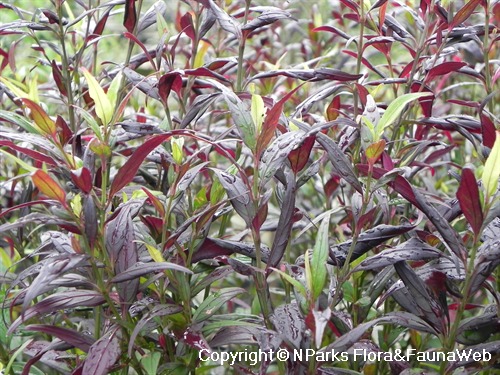
Name
Classifications and Characteristics
| Plant Division | Angiosperms (Flowering Seed Plants) |
|---|---|
| Plant Growth Form | Shrub |
| Mode of Nutrition | Autotrophic |
Biogeography
| Native Distribution | Madagascar and India |
|---|---|
| Native Habitat | Terrestrial |
| Preferred Climate Zone | Tropical |
| Local Conservation Status | Non-native |
Description and Ethnobotany
| Growth Form | An erect and bushy herbaceous plant, able to grow up to about 1.5 m tall and 0.8 wide. |
|---|---|
| Foliage | Dark purplish green leaves, opposite, lanceolate and slightly toothed margins, measuring about 11 cm long by 2 cm wide, foliage tends to be unequal in size. |
| Flowers | Light purple flowers are in a cone-shaped inflorescence, measuring up to about 5 cm long. |
| Fruit | Fruit is a capsule, measuring about 7 - 10 mm long, surface glandular and hairy. |
| Etymology | Genus Strobilanthes is derived from two Greek words - "strobilos"which means cone and "anthos" which means flower, and refers to the plant's inflorescence. Species anisophyllus refers to the plant with leaves that are oblique at the base. |
Landscaping Features
| Desirable Plant Features | Ornamental Flowers, Ornamental Foliage |
|---|---|
| Landscape Uses | Parks & Gardens, Small Gardens |
Plant Care and Propagation
| Light Preference | Semi-Shade |
|---|---|
| Water Preference | Moderate Water |
| Plant Growth Rate | Fast |
| Rootzone Tolerance | Moist Soils, Well-Drained Soils |
| Propagation Method | Seed, Stem Cutting |
Foliar
| Foliage Retention | Evergreen |
|---|---|
| Mature Foliage Colour(s) | Green, Purple |
| Foliar Arrangement Along Stem | Opposite |
| Foliar Attachment to Stem | Petiolate |
| Foliar Apex - Tip | Acuminate |
Floral (Angiosperm)
| Flower Colour(s) | Purple |
|---|---|
| Flower Grouping | Cluster / Inflorescence |
| Flower Location | Axillary |
Image Repository
Others
| Master ID | 30581 |
|---|---|
| Species ID | 4890 |
| Flora Disclaimer | The information in this website has been compiled from reliable sources, such as reference works on medicinal plants. It is not a substitute for medical advice or treatment and NParks does not purport to provide any medical advice. Readers should always consult his/her physician before using or consuming a plant for medicinal purposes. |




